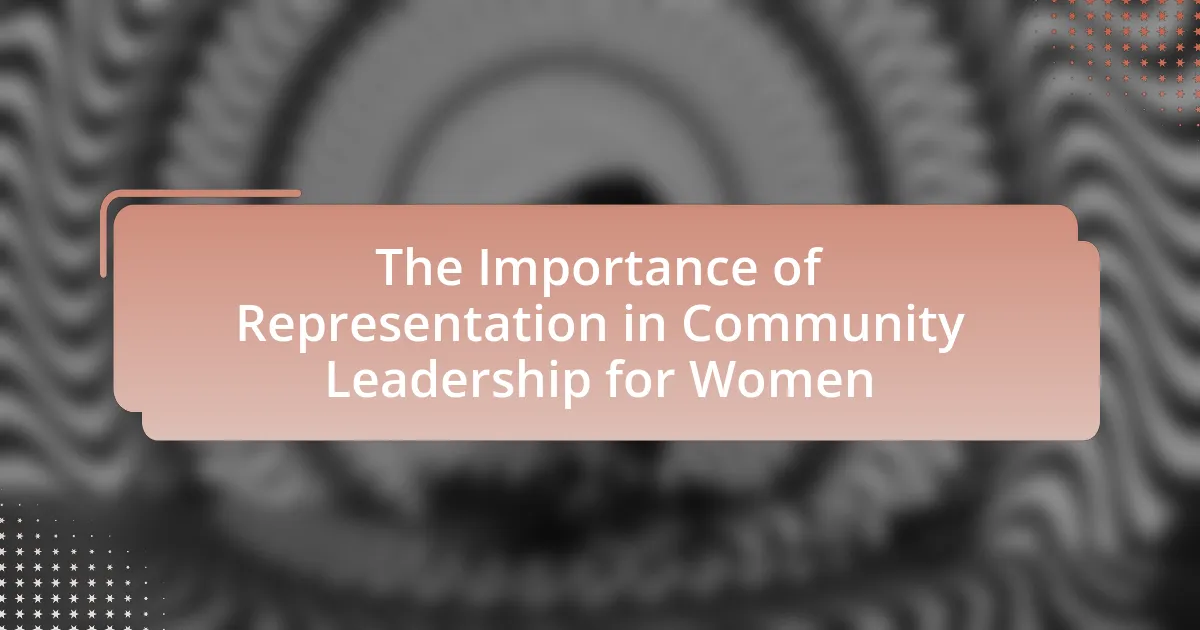The article focuses on the importance of representation in community leadership for women, highlighting how diverse leadership fosters equitable decision-making and addresses the unique challenges faced by women and marginalized groups. It discusses historical barriers to women’s representation, the impact of female leadership on community development, and the psychological effects of representation on women’s self-esteem and aspirations. Additionally, the article outlines successful initiatives and strategies to promote women’s leadership, including mentorship programs and policy changes, while emphasizing the role of community organizations in advocating for gender diversity in leadership roles.

What is the Importance of Representation in Community Leadership for Women?
Representation in community leadership for women is crucial as it fosters diverse perspectives and equitable decision-making. When women hold leadership positions, they can advocate for policies that address the unique challenges faced by women and marginalized groups, leading to more inclusive community development. Research indicates that organizations with female leaders are more likely to prioritize social issues, such as gender equality and family welfare, which enhances community well-being. Furthermore, the presence of women in leadership roles serves as a powerful role model effect, encouraging younger generations of women to aspire to leadership positions, thereby promoting long-term societal change.
Why is representation crucial in community leadership roles for women?
Representation is crucial in community leadership roles for women because it ensures diverse perspectives and equitable decision-making. When women occupy leadership positions, they bring unique experiences and insights that reflect the needs and challenges of the entire community. Research shows that organizations with diverse leadership teams are more innovative and effective; for instance, a McKinsey report found that companies in the top quartile for gender diversity on executive teams are 21% more likely to outperform on profitability. Furthermore, representation serves as a role model effect, inspiring younger generations of women to pursue leadership roles, thereby fostering a cycle of empowerment and inclusivity.
What historical barriers have women faced in achieving representation?
Women have historically faced numerous barriers in achieving representation, including legal restrictions, societal norms, and economic disadvantages. For instance, in many countries, women were denied the right to vote until the 20th century, with the 19th Amendment in the United States granting this right in 1920. Additionally, cultural beliefs often relegated women to domestic roles, limiting their participation in public life and leadership positions. Economic factors, such as lack of access to education and employment opportunities, further hindered women’s ability to engage in political and community leadership. These barriers have contributed to the underrepresentation of women in various sectors, including government and corporate leadership, where women held only 26.1% of parliamentary seats globally as of 2021, according to the Inter-Parliamentary Union.
How does representation impact decision-making in communities?
Representation significantly impacts decision-making in communities by ensuring diverse perspectives are included in the process. When women and other underrepresented groups participate in leadership roles, decisions reflect a broader range of experiences and needs, leading to more equitable outcomes. Research shows that communities with higher female representation in leadership positions tend to prioritize issues such as education, healthcare, and social services, which are often overlooked in male-dominated decision-making bodies. For instance, a study by the Inter-Parliamentary Union found that countries with at least 30% women in parliament are more likely to implement policies that benefit families and children. This evidence underscores the importance of representation in fostering inclusive and effective community decision-making.
What are the key benefits of having women in community leadership?
Having women in community leadership brings diverse perspectives that enhance decision-making and problem-solving. Research indicates that organizations with women in leadership roles are more likely to prioritize social issues, leading to improved community engagement and satisfaction. For instance, a study by McKinsey & Company found that companies with more women in leadership positions are 21% more likely to outperform their counterparts in terms of profitability. Additionally, women’s leadership often fosters inclusive environments, encouraging participation from underrepresented groups, which can lead to more equitable community development.
How does women’s leadership influence community development?
Women’s leadership significantly influences community development by fostering inclusive decision-making and promoting social equity. Research indicates that when women hold leadership positions, communities experience enhanced collaboration and improved outcomes in areas such as education, health, and economic growth. For instance, a study by the World Bank found that women’s participation in local governance leads to better public service delivery and increased community engagement. This correlation underscores the importance of women’s leadership in driving sustainable development and addressing the unique needs of diverse populations.
What role does diversity play in effective leadership?
Diversity plays a crucial role in effective leadership by enhancing decision-making and fostering innovation. Leaders who embrace diverse perspectives are better equipped to understand and address the needs of varied stakeholders, leading to more inclusive and effective strategies. Research from McKinsey & Company indicates that organizations with higher diversity levels are 35% more likely to outperform their peers in terms of financial returns. This correlation highlights how diverse leadership teams can leverage a wider range of experiences and viewpoints, ultimately driving better outcomes and fostering a culture of inclusivity.
How does representation affect women’s empowerment in communities?
Representation significantly enhances women’s empowerment in communities by ensuring that women’s voices and perspectives are included in decision-making processes. When women are represented in leadership roles, it leads to policies and initiatives that address their specific needs and challenges, fostering an environment where they can thrive. For instance, research by the World Economic Forum indicates that increasing women’s representation in political and economic spheres correlates with improved outcomes in health, education, and economic growth. This demonstrates that representation not only empowers women but also benefits the entire community by promoting inclusive development and social equity.
What are the psychological effects of representation on women leaders?
Representation positively impacts women leaders by enhancing their self-efficacy and reducing feelings of isolation. When women see others in leadership roles, it reinforces the belief that they too can succeed, which is supported by research indicating that role models significantly influence women’s aspirations and confidence levels. A study published in the Journal of Personality and Social Psychology found that women exposed to successful female leaders reported higher levels of self-esteem and motivation to pursue leadership positions. This psychological boost is crucial in overcoming systemic barriers and fostering a more inclusive leadership landscape.
How does seeing women in leadership roles inspire future generations?
Seeing women in leadership roles inspires future generations by providing relatable role models who demonstrate that success is attainable regardless of gender. Research indicates that girls who see women in leadership positions are more likely to aspire to leadership themselves; for instance, a study by the American Association of University Women found that girls with female role models are more likely to pursue careers in fields traditionally dominated by men. This visibility challenges stereotypes and encourages young women to envision themselves in leadership roles, fostering a culture of ambition and empowerment.
What impact does representation have on women’s self-esteem and confidence?
Representation positively impacts women’s self-esteem and confidence by providing relatable role models and validating their experiences. When women see themselves reflected in leadership positions, it fosters a sense of belonging and possibility, which can enhance their self-worth. Research indicates that representation in media and leadership roles can lead to increased aspirations among women; for instance, a study published in the journal “Psychological Science” found that women exposed to successful female leaders reported higher self-efficacy and motivation to pursue leadership roles themselves. This correlation underscores the importance of visibility and representation in shaping women’s perceptions of their capabilities and potential.
How can communities promote women’s representation in leadership?
Communities can promote women’s representation in leadership by implementing mentorship programs that connect aspiring female leaders with established women in leadership roles. Research indicates that mentorship significantly enhances women’s career advancement; for instance, a study by the American Psychological Association found that women with mentors are more likely to achieve leadership positions. Additionally, communities can establish policies that encourage gender diversity in leadership roles, such as setting quotas or targets for female representation in local government and organizations. Evidence from the World Economic Forum shows that countries with gender quotas have seen a notable increase in women’s participation in leadership, demonstrating the effectiveness of such measures.
What initiatives have proven successful in increasing women’s leadership roles?
Successful initiatives for increasing women’s leadership roles include mentorship programs, gender quotas, and leadership training workshops. Mentorship programs, such as those implemented by organizations like Catalyst, have shown that women with mentors are more likely to advance into leadership positions, with studies indicating a 25% increase in promotion rates for mentees. Gender quotas, adopted in countries like Norway, have led to a significant rise in female representation on corporate boards, achieving over 40% female board members within a decade. Leadership training workshops, exemplified by the Women’s Leadership Program at Harvard, have demonstrated effectiveness in equipping women with essential skills, resulting in a 30% increase in participants taking on leadership roles post-training. These initiatives collectively contribute to a more equitable representation of women in leadership.
How can mentorship programs support women in leadership positions?
Mentorship programs can support women in leadership positions by providing guidance, networking opportunities, and skill development tailored to their unique challenges. These programs connect women with experienced leaders who can share insights and strategies for navigating organizational dynamics, which is crucial given that women often face barriers to advancement in male-dominated environments. Research indicates that women with mentors are more likely to receive promotions and higher salaries; for instance, a study by the American Psychological Association found that mentorship significantly enhances career outcomes for women, leading to increased representation in leadership roles.

What challenges do women face in achieving representation in community leadership?
Women face significant challenges in achieving representation in community leadership, primarily due to systemic barriers, societal biases, and lack of support networks. Systemic barriers include institutional practices that favor male candidates, such as biased recruitment processes and limited access to leadership training. Societal biases manifest in stereotypes that question women’s leadership abilities, often leading to underrepresentation in decision-making roles. Additionally, women frequently encounter a lack of mentorship and sponsorship opportunities, which are crucial for career advancement. According to a 2020 report by the World Economic Forum, women hold only 25% of leadership positions globally, highlighting the persistent gender gap in leadership roles.
What societal norms hinder women’s leadership opportunities?
Societal norms that hinder women’s leadership opportunities include gender stereotypes, traditional gender roles, and biases in professional settings. Gender stereotypes often portray women as less competent leaders, which can lead to discrimination in hiring and promotion processes. Traditional gender roles assign caregiving responsibilities primarily to women, limiting their availability for leadership positions. Additionally, biases in professional environments, such as the perception that women are less assertive or decisive, further restrict their advancement. Research from McKinsey & Company indicates that women are underrepresented in leadership roles, with only 28% of senior vice president roles held by women, highlighting the impact of these societal norms on women’s leadership opportunities.
How do work-life balance issues affect women’s participation in leadership?
Work-life balance issues significantly hinder women’s participation in leadership roles. Research indicates that women often face greater challenges in balancing professional responsibilities with family obligations, which can lead to decreased opportunities for advancement. For instance, a study by McKinsey & Company in 2021 found that women are 1.5 times more likely than men to be responsible for household duties, impacting their availability for leadership positions. Additionally, the lack of flexible work arrangements exacerbates this issue, as women may feel compelled to prioritize family over career progression. Consequently, these factors contribute to a persistent gender gap in leadership roles across various sectors.
What role does gender bias play in community leadership selection processes?
Gender bias significantly hinders equitable community leadership selection processes by favoring male candidates over female candidates. Research indicates that women often face stereotypes that question their leadership abilities, leading to fewer opportunities for them to be selected for leadership roles. For instance, a study by the American Association of University Women found that women are less likely to be nominated for leadership positions due to perceptions that they are less competent than their male counterparts. This bias not only affects the selection outcomes but also perpetuates a cycle of underrepresentation, as fewer women in leadership roles can discourage future female candidates from pursuing such positions.
What strategies can be implemented to overcome these challenges?
To overcome challenges in women’s representation in community leadership, implementing mentorship programs is essential. These programs connect aspiring female leaders with experienced mentors who provide guidance, support, and networking opportunities, fostering confidence and skill development. Research indicates that mentorship significantly enhances women’s leadership aspirations and success rates, as evidenced by a study published in the Journal of Leadership Studies, which found that women with mentors are more likely to pursue leadership roles and achieve career advancement. Additionally, promoting policies that ensure equal opportunities in leadership positions, such as gender quotas, can effectively increase women’s representation. Countries like Norway have successfully implemented gender quotas, resulting in a substantial rise in female representation in corporate boards, demonstrating the effectiveness of such strategies.
How can policy changes support women’s representation in leadership?
Policy changes can support women’s representation in leadership by implementing quotas and affirmative action initiatives that ensure a minimum percentage of women in decision-making roles. For instance, countries like Norway have mandated that at least 40% of board members in publicly listed companies must be women, resulting in increased female representation in leadership positions. Additionally, policies that promote work-life balance, such as parental leave and flexible working hours, can help women pursue leadership roles by reducing barriers related to family responsibilities. Research from McKinsey & Company indicates that companies with more women in leadership positions are 21% more likely to outperform their counterparts in profitability, demonstrating the positive impact of such policy changes on organizational success.
What role do community organizations play in advocating for women’s leadership?
Community organizations play a crucial role in advocating for women’s leadership by providing resources, support, and platforms for women to develop their leadership skills. These organizations often facilitate training programs, mentorship opportunities, and networking events that empower women to take on leadership roles in various sectors. For instance, studies have shown that women involved in community organizations are more likely to pursue leadership positions, as these organizations create an environment that fosters confidence and skill development. Additionally, community organizations often engage in advocacy efforts to influence policy changes that promote gender equality in leadership, thereby contributing to a more equitable representation of women in decision-making roles.
What practical steps can individuals take to support women’s representation in leadership?
Individuals can support women’s representation in leadership by actively advocating for gender diversity in decision-making roles. This can be achieved by mentoring women, promoting their achievements, and encouraging organizations to implement policies that prioritize gender equality. Research shows that companies with more women in leadership positions experience better financial performance and improved organizational culture. For instance, a McKinsey report found that organizations in the top quartile for gender diversity are 21% more likely to outperform on profitability. Additionally, individuals can participate in or support initiatives that aim to increase women’s access to leadership training and networking opportunities, further enhancing their representation in leadership roles.


